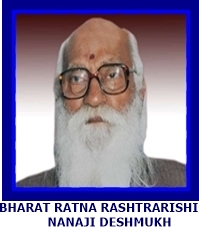
Bharat Ratna Nanaji Deshmukh.
Since ancient times, Indians have used the proverb Annamaya pran (Man can not survive without food). This proverb is nothing but a fact of life. And the only source of this invaluable food is agricultural land. In terms of arable land and production, India ranks first in the community of Nations. But it is extremely sad, that in comparison to other countries, our current productivity per acre is quite low. Because of low productivity of crops, agriculture is considered to be loss-making business. Unless we convert it to profit making one, our country cannot achieve prosperity.
After Independence, our agricultural policies were influenced greatly by the big landlords. As a result of this, the large and needy sections of small peasants were neglected. That is why even after 60 years of Independence, three- fourth of our agricultural land remains un- economical. Because of this lacuna in the agricultural policy, not only have small farmers remained below the poverty line, our country has not prospered agriculturally.
The illiterate marginal farmers of uneconomic agricultural land are today considered as deadweight in the country. It is assumed that landholding of below two and half acres is a non-profitable unit.
Our Krishi Vigyan Kendra, Majhgawan (Satna) has successfully proved that uneconomic holdings can be converted into economic holdings. This center has shown that even such small unit owner/farmers can save Rs. 5000 per year after meeting their family’s annual expenses and these farmers can too contribute to the nation’s capital formation. This contribution can grow even bigger. The then Director General, Indian Council of Agriculture Research (ICAR) Dr. Panjab Singh , and the Director General of CAPART, Shri Rangan Datta were surprised to see these successful experiments. These models are examples of how constructive programs can be of great help in the development of our nation.
To increase agriculture production, Irrigation Management is must. Nowadays, the pumping of ground water with tube wells has increased at an alarming rate, and recharging of the ground water has been neglected. As a result, the water table in the country is rapidly decreasing. Wells in the Villages are going dry. In many villages, drinking water has become a serious problem. Rainwater is wasted everywhere. The tradition of preserving rain water has almost vanished. Rain water is no longer added to the ground water. Because of the lack of recharging the ground water with rain, the water table is receding very fast. Serious attention has to be given to this problem.
Our KVK Scientists has tried to tackle the issue of water scarcity. In many villages where the KVK focused their activities, villagers use to carry drinking water from a distance of 5 to 6 km. At least one person (generally a woman) from each family was engaged in fetching drinking water full time. Under Rajiv Gandhi Watershed Area Management Mission, the watershed development programme was implemented in 19 villages. Under the able guidance of KVK, Majhgawan scientists, villagers started constructing check dam to stop the flowing water. Men, women and children wholeheartedly participated in the programme. The villager’s initiative and commitment changed the scenario of these villages. Now one can find 10-15 ft. of water in the local wells even in the month of May and June. These wells earlier used to go dry. As a result of these massive efforts more than 4,000 hectares of agricultural land has been irrigated.
I am happy to see that Deendayal Research Institutes’ Krishi Vigyan Kendras are giving full cognizance to develop low cost replicable models and focusing on improvement in farming system with the emphasis on long term fertility and sustained productivity; evolving suitable cropping system with logical mix of cereals/ coarse cereals, pulses, oilseeds, vegetables and fruits giving due regards to maximum water use efficiency, agro-climatic suitability, productivity and economic viability aspect and lively hood support system in resource poor areas with pre dominance of small and marginal farmer, landless labourers, farm women and rural youths primarily in tribal areas.